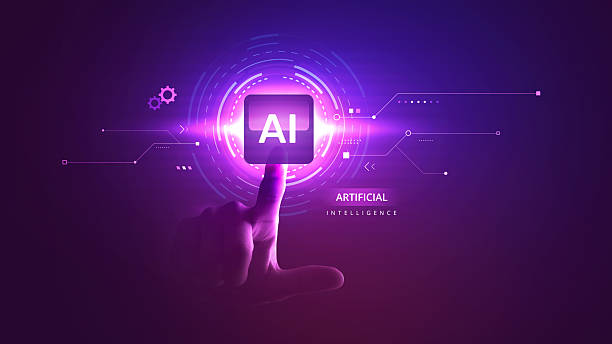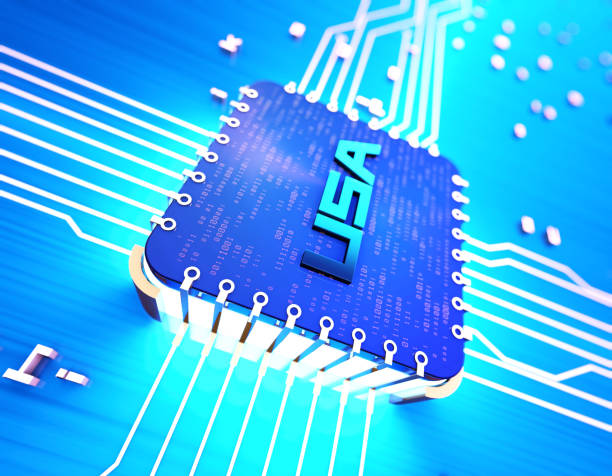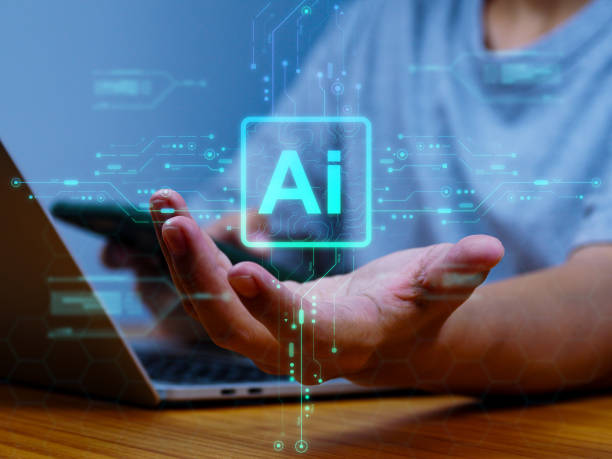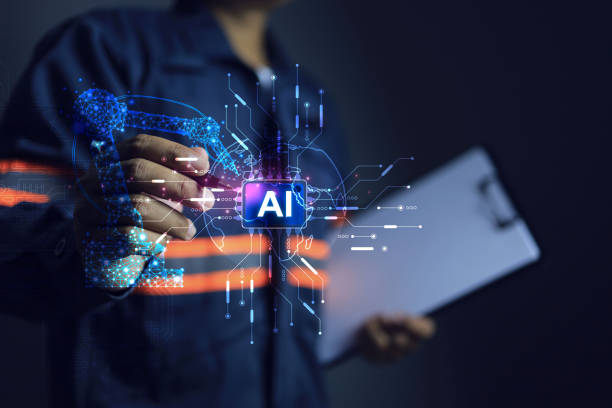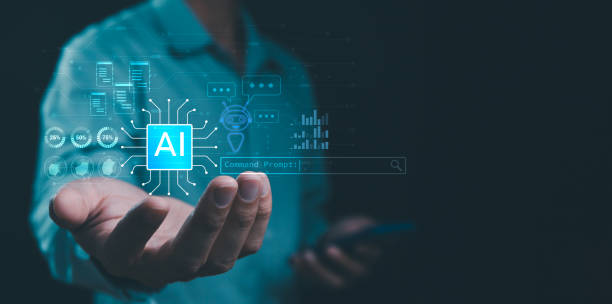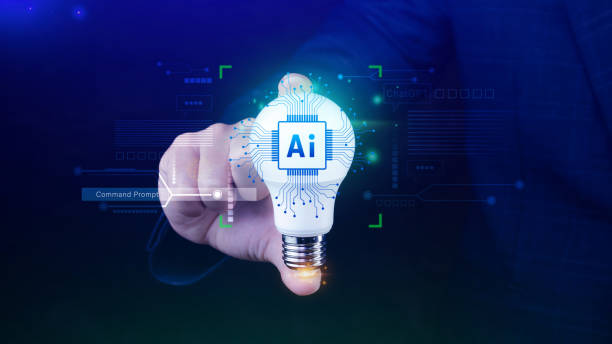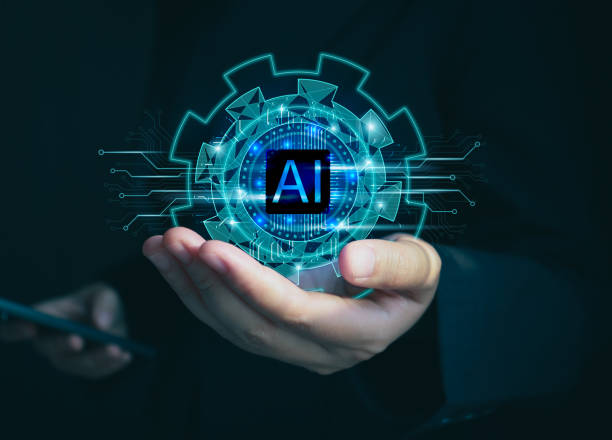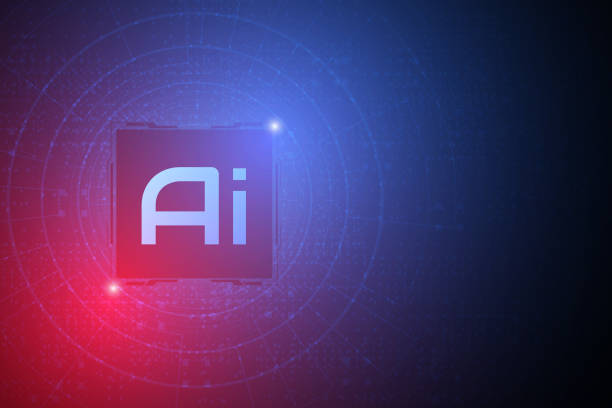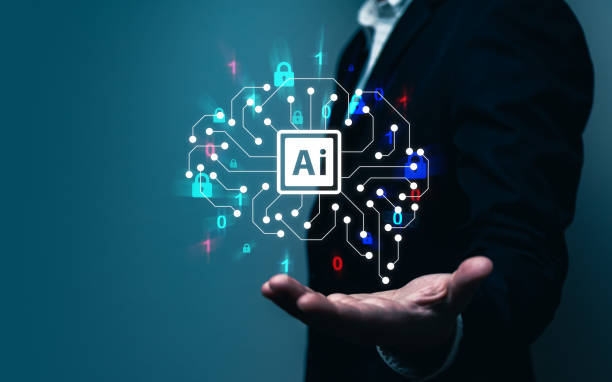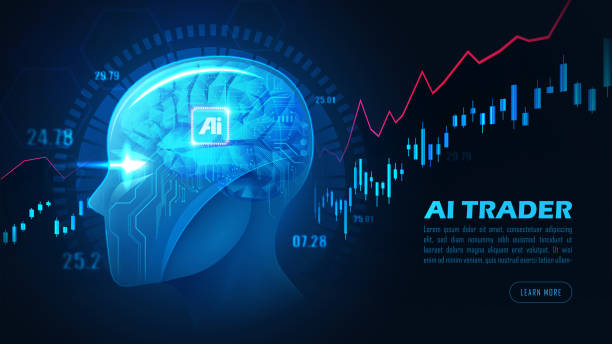### What is an Artificial Intelligence Robot and How Does It Work?
An Artificial Intelligence Robot is a combination of two fields: #Robotics and #Artificial_Intelligence.
In short, an #AI_Robot is a physical or virtual machine that, using artificial intelligence algorithms, is capable of performing tasks that typically require human intelligence.
These tasks include learning, reasoning, problem-solving, natural language understanding, and pattern recognition.
AI robots can operate independently or under human supervision.
How an AI robot works depends on its type and complexity, but it generally involves the following steps:
- Data Acquisition: The robot collects information from its surrounding environment through its sensors (such as cameras, microphones, touch sensors, etc.).
- Data Processing: The collected data is processed by artificial intelligence algorithms (such as neural networks, decision trees, etc.).
This processing includes pattern recognition, extraction of useful information, and data interpretation. - Decision Making: Based on the processed information, the robot decides what action to take.
This decision-making can be based on predefined rules or using machine learning algorithms. - Execution: The robot executes the desired action using its actuators (such as motors, arms, speakers, etc.).
- Learning: By analyzing the results of its actions, the robot learns how to improve its performance in the future.
This learning can be done automatically or with human assistance.
For more information about artificial intelligence, you can refer to [Wikipedia](https://fa.wikipedia.org/wiki/%D9%87%D9%88%D8%B4_%D9%85%D8%B5%D9%86%D9%88%D8%B9%DB%8C).
Are you dissatisfied with the low sales of your online store?
Rasaweb is your solution for having a professional and high-selling online store.
✅ Significant increase in sales and revenue
✅ Easy and enjoyable shopping experience for customers
⚡ Get a free consultation from Rasaweb now!
Various Applications of AI Robots in Different Industries
AI robots have extensive applications in various industries.
Some of the most important applications include:
- Manufacturing: AI robots are used in production lines to perform repetitive and precise tasks, such as welding, painting, and assembling parts.
These robots can work faster and more accurately than humans and reduce human error. - Customer Service: Chatbots using Natural Language Processing (NLP) can answer customer questions and solve their problems.
These robots can be available 24/7 and reduce the workload of customer service employees. - Healthcare: AI robots are used in precise surgeries, patient rehabilitation, and providing remote healthcare.
These robots can operate with greater precision than humans and help improve treatment outcomes. - Transportation: AI robots are used in self-driving cars, drones, and intelligent transportation systems.
These robots can increase the safety and efficiency of transportation by reducing accidents and traffic. - Security: AI robots are used in surveillance systems, facial recognition, and identifying security threats.
These robots can automatically identify suspicious events and alert security forces.
Click here to preview your posts with PRO themes ››
AI robots, with their ability to learn and adapt to different conditions, are transforming various industries.
Advantages and Disadvantages of Using AI Robots
Using AI robots has numerous advantages and disadvantages.
Understanding these advantages and disadvantages is essential for making informed decisions about the use of this technology.
Advantages:
- Increased Efficiency and Productivity: AI robots can perform tasks faster and more accurately than humans, helping to increase productivity.
- Cost Reduction: Using AI robots can reduce labor costs and lead to cost savings in the long run.
- Improved Safety: AI robots can work in hazardous and unsuitable environments for humans, ensuring the safety of employees.
- 24/7 Availability: AI robots can work around the clock and provide services to customers without interruption.
- Accuracy and Stability: AI robots can perform tasks with high accuracy and stability, reducing human error.
Disadvantages:
- High Initial Cost: Purchasing and deploying AI robots can be expensive initially.
- Need for Expertise: Programming, maintaining, and repairing AI robots require specialized personnel.
- Job Displacement: The use of AI robots can lead to job losses for some individuals.
- Ethical Concerns: The use of AI robots can raise ethical concerns about privacy, discrimination, and accountability.
- Limitations: AI robots still have limitations in some areas such as creativity, empathy, and intuitive understanding.
| Advantage | Description |
|---|---|
| Increased Efficiency | AI robots can perform tasks faster and more accurately. |
| Cost Reduction | Using AI robots can reduce labor costs. |
| Improved Safety | AI robots can work in hazardous environments without endangering humans. |
Ultimately, the decision to use AI robots should be made considering its advantages and disadvantages and in accordance with the specific needs and conditions of each organization.
Challenges of Implementing and Developing AI Robots
Implementing and developing AI robots comes with numerous challenges.
These challenges include technical, economic, social, and ethical aspects.
- Technical Challenges:
- Data Collection and Processing: Training AI robots requires a large volume of high-quality data.
Collecting, labeling, and processing this data can be time-consuming and costly. - Developing Advanced Algorithms: Developing AI algorithms that can effectively cope with the complexities of the real world is a major challenge.
- System Integration: Integrating AI robots with existing systems can be complex and difficult.
- Data Collection and Processing: Training AI robots requires a large volume of high-quality data.
- Economic Challenges:
- High Development Cost: Developing and implementing AI robots can be expensive.
- Return on Investment: Determining and proving the return on investment (ROI) of investing in AI robots can be difficult.
- Labor Market Changes: The use of AI robots can lead to changes in the labor market and job displacement for some individuals.
- Social Challenges:
- Public Acceptance: Public acceptance of AI robots may face resistance.
- Trust: Building trust in AI robots and ensuring their proper functioning is an important challenge.
- Privacy: Collecting and using data by AI robots can raise privacy concerns.
- Ethical Challenges:
- Accountability: Determining accountability in case of errors or damages caused by AI robots is a complex challenge.
- Discrimination: AI algorithms may inadvertently be discriminatory.
- Control: Ensuring that AI robots are under human control and not used for unauthorized purposes is an important challenge.
Overcoming these challenges requires collaboration between various experts, policymakers, and the general public.
Are you worried about the low conversion rate of your online store and not achieving your desired sales?
Rasaweb is your specialized solution for having a successful online store.
✅ Significant increase in conversion rate and sales
✅ Professional and user-friendly design to satisfy customers
⚡ Are you ready for a transformation in online sales? Get a free consultation!
Future of AI Robots: Visions and Possibilities
The future of AI robots is very bright and full of possibilities.
Rapid advances in artificial intelligence, robotics, and related technologies promise significant transformations in the coming years.
Some of the future visions of AI robots include:
- Expanding Applications: AI robots will find broader applications in various industries, including manufacturing, services, healthcare, transportation, and security.
- Increasing Intelligence: AI robots will become more intelligent, automated, and independent.
- Better Interaction with Humans: AI robots will be able to interact more naturally and effectively with humans.
- Development of Humanoid Robots: Humanoid robots with more advanced capabilities and a more natural appearance will be developed.
- Integration with Other Technologies: AI robots will be integrated with other technologies such as the Internet of Things (IoT), blockchain, and augmented reality (AR).
Some of the future possibilities of AI robots include:
- Complete Automation of Some Industries: AI robots will be able to fully automate some industries.
- Creating New Jobs: Developing and maintaining AI robots will create new jobs.
- Change in Lifestyle: AI robots will change the way we live, work, and interact with each other.
- Creating New Dangers: Misuse of AI robots may create new dangers.
To capitalize on the opportunities and mitigate the risks arising from the development of AI robots, careful planning and collaboration between various experts, policymakers, and the general public are needed.
Artificial Intelligence Robot is increasingly used in various industries.
Ethical Considerations in the Design and Use of AI Robots
The design and use of AI robots are accompanied by important ethical considerations that must be addressed.
Failure to address these considerations can lead to serious problems and harm.
Some of the most important ethical considerations include:
- Accountability: Who is responsible for the performance of an AI robot? In case of an error or damage, who should be held accountable?
- Transparency: AI algorithms should be transparent and understandable.
The robot’s decision-making process should be explainable. - Privacy: AI robots should not collect or use personal information without their consent.
- Discrimination: AI algorithms should not be discriminatory.
They should not make decisions based on gender, race, religion, or other individual characteristics. - Security: AI robots should be secure and protected against cyber attacks.
- Control: AI robots should be under human control and not used for unauthorized purposes.
- Impact on Employment: The use of AI robots should not lead to significant job losses.
To comply with these ethical considerations, specific ethical and legal standards should be developed for the design and use of AI robots.
Also, necessary training should be provided to experts and the general public so that they can use this technology responsibly.
Proper use of AI robots helps advance technology.
How to Build an AI Robot: A Step-by-Step Guide
Building an AI robot is a complex and challenging project, but by following a step-by-step guide, you can do it.
Here’s a general guide to building an AI robot:
- Define the Goal: First, you need to define your goal for building the robot.
What is your robot supposed to do? What problems will it solve? - Select Hardware: Based on your goal, you need to select the appropriate hardware.
This hardware may include:- Microcontroller: The brain of your robot, responsible for processing information and controlling other components.
- Sensors: Used to collect information from the surrounding environment.
- Actuators: Used to perform desired actions.
- Power Source: Used to power the robot.
- Select Software: To program and control your robot, you need to select the appropriate software.
This software may include:- Programming Language: To write the robot’s code, you need to choose a programming language.
- AI Libraries: To use artificial intelligence algorithms, you can use pre-made libraries.
- Integrated Development Environment (IDE): To write, edit, and debug your code, you can use an IDE.
- Collect Data: To train your robot, you need to collect the appropriate data.
This data should be relevant to your goal of building the robot. - Train the AI Model: Using the collected data, you need to train your AI model.
- Integrate Hardware and Software: After training the AI model, you need to integrate it with your robot’s hardware.
- Test and Improve: After integrating hardware and software, you need to test your robot and improve its performance.
To get started, you can use pre-made projects and online tutorials.
Also, you can join forums and groups related to robotics and artificial intelligence and use the experiences of others.
| Step | Description |
|---|---|
| Define the Goal | Specify what the robot will do. |
| Select Hardware | Choose the physical components of the robot. |
| Select Software | Choose the programming and artificial intelligence tools. |
Introducing Some Open Source AI Robot Projects
Open source AI robot projects are valuable resources for learning, developing, and participating in this field.
These projects allow you to use pre-made code, models, and data and participate in their development.
AI robots in open source means free access to their source codes.
Some popular open source AI robot projects include:
- ROS (Robot Operating System): A flexible software framework for developing robotic applications.
ROS provides various tools and libraries for building complex robots.
[ROS Website](http://www.ros.org/) - OpenCV (Open Source Computer Vision Library): A free software library for image processing and computer vision.
OpenCV includes various algorithms for object detection, face detection, motion tracking, and more. - TensorFlow: An open source software framework for machine learning.
TensorFlow provides various tools and APIs for building and training machine learning models. - PyTorch: Another open source software framework for machine learning.
PyTorch is very popular among researchers and developers due to its flexibility and ease of use. - GPT-2 and GPT-3: Large language models developed by OpenAI.
These models are capable of generating high-quality text, translating languages, and answering questions.
Using these open source projects, you can quickly and easily develop your own AI robots and participate in this field.
To get started, you can study online tutorials and documentation related to these projects.
Is your current online store design causing you to lose customers and sales?
Rasaweb is your solution with modern and user-friendly online store design!
✅ Significant increase in conversion rate and sales
✅ Creating strong branding and gaining customer trust
⚡ Get a free online store design consultation from Rasaweb!
Impact of AI Robots on the Future of Jobs and the Labor Market
The impact of AI robots on the future of jobs and the labor market is a controversial issue.
Some believe that AI robots will lead to significant job losses, while others believe that this technology will create new jobs and increase productivity.
In reality, the impact of AI robots on the labor market is more complex than that.
Some jobs, especially those that are repetitive and routine, are more at risk of automation.
In contrast, jobs that require creativity, empathy, social skills, and critical thinking are less at risk.
The use of AI robots is increasing day by day.
In addition, AI robots can create new jobs.
For example, AI specialists, robotics engineers, data specialists, and business analysts are currently in high demand and are expected to increase in the future.
To prepare for the future of the labor market, we need to learn the skills required to work with AI robots.
These skills include:
- Technical Skills: Programming, machine learning, data analysis
- Soft Skills: Problem-solving, critical thinking, creativity, collaboration, communication
- Continuous Learning: Given the rapid pace of technological advances, we need to constantly update our skills.
By learning these skills, we can take advantage of the new job opportunities that AI robots create and be successful in the future labor market.
Resources for Learning More About AI Robots
To learn more about AI robots, many resources are available.
These resources include books, online courses, scientific articles, blogs, and online forums.
Some helpful resources to get started include:
- Books:
- “Artificial Intelligence A Modern Approach” by Stuart Russell and Peter Norvig
- “Hands-On Machine Learning with Scikit-Learn, Keras & TensorFlow” by Aurélien Géron
- “Robotics, Vision and Control Fundamental Algorithms” by Peter Corke
- Online Courses:
- Coursera: Machine Learning by Andrew Ng
- edX: Artificial Intelligence (AI)
- Udacity: Robotics Nanodegree
- Websites and Blogs:
- [MIT News](https://news.mit.edu/topic/artificial-intelligence)
- [OpenAI Blog](https://openai.com/blog/)
- [Towards Data Science](https://towardsdatascience.com/)
- Online Forums:
- [Reddit r/robotics](https://www.reddit.com/r/robotics/)
- [Stack Overflow](https://stackoverflow.com/)
Using these resources, you can increase your knowledge of AI robots and become an expert in this field.
Also, you can participate in open source AI robot projects and gain practical experience.
AI robots are taking over the world.
Frequently Asked Questions
| Question | Answer |
|---|---|
| What is an AI robot? | It is a robot that uses artificial intelligence capabilities to understand the environment, reason, learn, and make decisions to perform complex tasks independently. |
| What is the main difference between a regular robot and an AI robot? | AI robots can learn and adapt to their environment, while regular robots typically operate based on fixed and predetermined programming. |
| In what areas are AI robots used? | In areas such as industry (production lines), medicine (robotic surgeries), services (customer support, smart vacuum cleaners), exploration (space and underwater), and entertainment. |
| How do AI robots learn? | They acquire new skills through machine learning and deep learning algorithms by analyzing large data sets and identifying patterns. |
| Can AI robots have emotions? | Currently, no. They can identify or simulate emotions, but they do not have real experiences of emotions like humans. |
| What are the most important advantages of using AI robots? | Increased productivity, reduced human error, performing dangerous or repetitive tasks, and providing new and efficient services. |
| What challenges exist in developing AI robots? | The need for large and high-quality data, complexity of algorithms, ethical issues, cybersecurity, and high cost of research and development. |
| Are AI robots dangerous to humans? | By following safe design principles and ethical regulations, no. Concerns are more related to social and economic impacts such as changes in the labor market. |
| What is an example of an AI robot in everyday life? | Smart vacuum robots (such as Roomba) that automatically map and clean the house, or intelligent voice assistants (such as Siri and Alexa). |
| How is the future of AI robots predicted? | They are expected to become smarter, more autonomous, and able to interact more complexly with humans and play a more prominent role in industry, medicine, transportation, and everyday life. |
And other services of Rasa Web Advertising Agency in the field of advertising
Intelligent UI/UX: A creative platform to improve customer behavior analysis with attractive user interface design.
Intelligent Direct Marketing: A new service to increase SEO ranking through Google Ads management.
Intelligent Custom Software: A combination of creativity and technology to increase click-through rates by using real data.
Intelligent Marketing Automation: A professional solution for analyzing customer behavior with a focus on dedicated programming.
Intelligent Brand Identity: An effective tool to analyze customer behavior using intelligent data analysis.
And over a hundred other services in the field of internet advertising, advertising consulting and organizational solutions
Internet Advertising | Advertising Strategy | Advertorial Reports
Resources
Intelligent Robot and its Consequences in Everyday Life
,What can be done with Artificial Intelligence?
,Let me tell you the latest achievements of Artificial Intelligence
,Artificial Intelligence in the Heart of Bazaars
? Are you ready to boost your business in the digital world? Rasaweb Digital Marketing Agency, with expertise in SEO, content marketing, and modern user interface design, is with you to reach the peaks of success.
📍 Tehran, Mirdamad Street, next to the Central Bank, Southern Kazerun Alley, Ramin Alley No. 6

